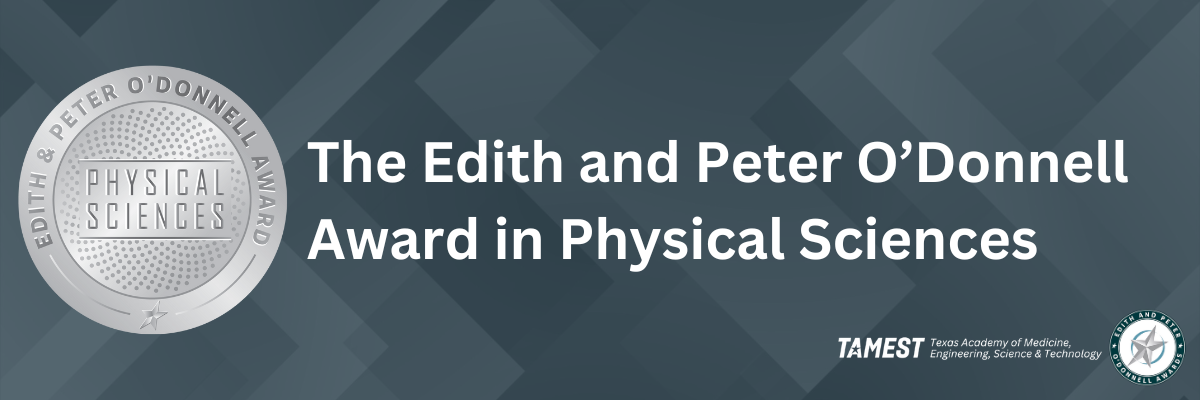
About the Edith and Peter O’Donnell Award in Physical Sciences
The Edith and Peter O’Donnell Awards were established in 2006. They are named in honor of Edith and Peter O’Donnell, who were among Texas’ most devoted advocates for excellence in scientific advancement and STEM education. The awards recognize rising star Texas researchers who are addressing the essential role that science and technology play in society and whose work meets the highest standards of exemplary professional performance, creativity and resourcefulness.
The Edith and Peter O’Donnell Award in Physical Sciences honors Texas researchers at academic institutions with a focus in the physical sciences with a $25,000 honorarium, profile video and an invitation to present their research at the TAMEST Annual Conference.
Thanks to a $1.15 million gift from the O’Donnell Foundation in 2022, the O’Donnell Awards were expanded to include an additional science award so that awards could be given each year in both Biological and Physical Sciences categories. Previously, the science award alternated between biological sciences and physical sciences annually.
Most Recent Physical Sciences Recipient

The observable Universe is estimated to be about 13.8 billion years old, and Dr. Casey and her team are trying to find uniquely massive galaxies from its first billion years. These galaxies are on the most extreme margins of what the Universe can produce. To do so, Dr. Casey leads the COSMOS-Web Survey, made up of an international team of hundreds of scientists with the aim of constructing the largest image of the distant Universe that has ever been created. COSMOS-Web was James Webb Space Telescope’s (JWST) largest public survey in its first year and exceeds the scale of the Hubble Space Telescope’s Ultra Deep Field by 200 times.
By finding such extreme sources from the most powerful telescopes in the world, Dr. Casey can test the fundamental laws of physics in the primordial Universe. The goal is to see how the first galaxies, the first stars and even the first black holes formed 13 billion years ago compared to those formed today. The JWST’s unique capabilities allows Dr. Casey’s team to see objects 100 times fainter than previous telescopes could see in infrared light and reach much farther back in time. By searching for the brightest beacons at the longest wavelengths, her team can find some of the earliest galaxies that seemingly outshine all others.
Such exceptionally bright galaxies test the limits of our cosmological model for how the Universe formed and changed with time. These galaxies, seen just a few hundred million years after the Big Bang, had to assemble over a very short period of time to shine so brightly. Her findings are unexpected because it implies there was extremely efficient star formation that isn’t seen in the Universe today. These discoveries have allowed scientists to hone their understanding of the early Universe. Dr. Casey’s goal with the COSMOS-Web project is to dig deeper and not just discover exceptionally bright galaxies, but also map out where they live in the large-scale structure of the cosmos.
Past Physical Sciences Recipients
For his innovative work in the field of decontamination.
Learn More >
Erez Lieberman Aiden, Ph.D., Baylor College of Medicine | 2023
For dramatically impacting the understanding of genomic 3D structures and the role and processes of the human genome.
Learn More >
Sarbajit Banerjee, Ph.D., Texas A&M University | 2022
For his utilization of solid-state chemistry and materials science to impact the future of new technologies in energy conversion, energy storage, computing and even artificial intelligence.
Learn More >
Watch Dr. Banerjee’s Award Acceptance >
Alessandra Corsi, Ph.D., Texas Tech University | 2020
For her paradigm-shifting research on the merger of stars and black holes. Dr. Corsi uncovered a “multisensory” exploration process of our universe, where gravitational waves tell part of the story and light then completes it.
Learn More >
Watch Dr. Corsi’s Award Acceptance >
Xiaoqin Elaine Li, Ph.D., The University of Texas at Austin | 2018
For her research focus on the interaction of light and matter at the nanoscale in quantum materials. Her innovative work has helped create and control materials that can emit one photon at a time.
Learn More >
Watch Dr. Li’s Award Acceptance >
Alessio Figalli, Ph.D., The University of Texas at Austin | 2016
For tackling questions of optimization related to the most economical way to transport and distribute goods or resources. Recently, his work has been applied in meteorology to describe how clouds evolve over time, a discovery that contributes to better models of complex climate phenomena.
Learn More >
Watch Dr. Figalli’s Award Acceptance >
Zhifeng Ren, Ph.D., University of Houston | 2014
For seminal contributions to five scientific fields: carbon nanotubes, thermoelectrics, zinc oxide nanowires, high temperature superconductivity and molecule delivery/sensing.
Learn More >
Watch Dr. Ren’s Award Acceptance >
Karl Gebhardt, Ph.D., The University of Texas at Austin | 2012
For the discovery that the masses of the central black hole and the inner regions of a galaxy are correlated.
Learn More >
Paul S. Cremer, Ph.D., Texas A&M University | 2010
For his work including a fundamental understanding of protein adsorption, multivalent binding on lipid membranes, and more.
Learn More >
Edward M. Marcotte, Ph.D., The University of Texas at Austin | 2008
For exceptional contributions to functional genomics and proteomics.
Learn More >

